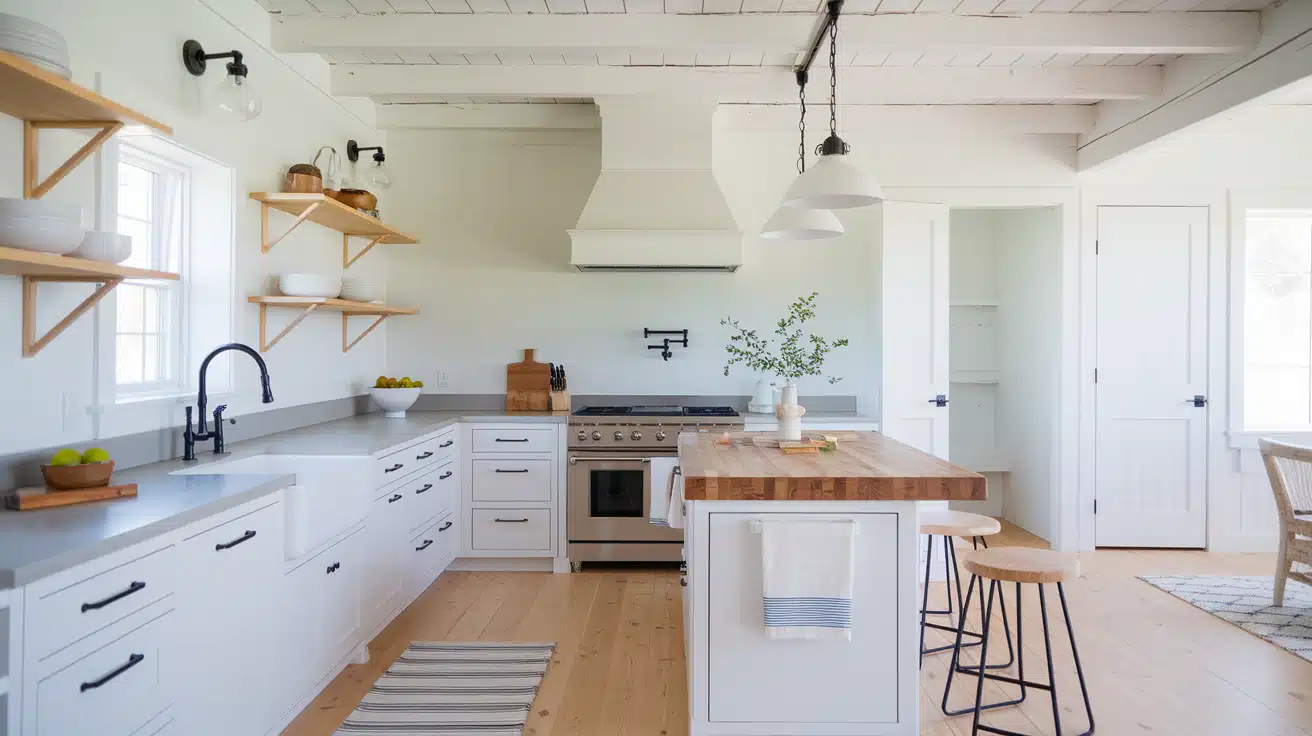Are your kitchen walls plain and outdated? A rustic minimalist style can make your space both useful and beautiful.
Many homeowners want the warmth of wood with the calm of less stuff. This mix works in any home – from city flats to country houses.
With the right changes, you can create a kitchen that feels open, warm, and personal. These 12 ideas will show you how to use natural materials, simple shapes, and smart storage to build a kitchen you’ll love to use.
Read on to learn how to transform your kitchen into a clean, cozy space that combines rustic charm with simple design.
What is a Rustic Minimalist Kitchen?
A rustic minimalist kitchen combines two design styles:
Rustic elements:
- Natural materials (wood, stone, metal)
- Textured surfaces with visible grain
- Earthy colors (browns, creams, tans)
- Handcrafted or vintage items
Minimalist elements:
- Clean lines and simple shapes
- Few decorative items
- Open, uncluttered spaces
- Practical, useful design
- Neutral colors
This blend creates spaces that feel warm from rustic touches while keeping the calm, orderly feel of minimalism. The style uses open shelving, wood surfaces, and careful textures instead of busy patterns or excess items.
12 Popular Rustic Minimalist Kitchen Ideas
These design ideas combine natural materials with simple forms to create kitchens that feel both warm and orderly.
1. Open Wooden Shelving
Open wooden shelves bring a warm touch to your kitchen walls. Unlike closed cabinets, they show off your most useful items. Choose sturdy pine, oak, or maple boards with simple brackets.
Keep them lightly stained to show the wood grain. Place only your most-used dishes, clear jars of dry goods, and a few plants on these shelves. The key is to avoid filling every inch. This setup creates both visual space and practical storage in your kitchen.
2. Exposed Ceiling Beams
Wooden beams draw the eye upward and make small kitchens feel larger. They add texture without taking up floor space. If your home lacks real beams, you can install fake ones made from hollow wood boxes.
Paint them in a shade darker than your ceiling for contrast, or keep them natural. The beams work well with both high and low ceilings. They bring a farm-house feel that balances well with clean-lined cabinets and simple appliances.
3. Stone Countertops
Stone surfaces bring nature into your kitchen. Options include rough-edged granite, smooth soapstone, or light-colored marble with subtle veins. These materials can handle hot pots and knife work.
Each stone has small marks that make it one-of-a-kind. Choose matte finishes rather than high polish for a more subtle look.
The natural color shifts in stone add visual interest without bright colors. They work well with wood tones and white cabinets for a calm, mixed-material effect.
4. Farmhouse Sink
A big, deep sink becomes the heart of a work area. White fireclay farmhouse sinks stick out slightly from cabinets, showing their front panel. This old-school style offers major function in a simple shape.
The wide basin fits large pots and baking sheets with ease. No divider means more room for bulky items. For a more raw look, try hammered copper or concrete versions. Pair with a simple pull-down faucet in brass or black to complete the look.
5. Butcher Block Island
A wooden island adds warmth to a kitchen with stone and metal. Maple, walnut, or oak tops can handle years of use. The wood softens the look of steel appliances nearby. Choose an island with open shelves below for pots and tools.
A slim model works in tight spaces, while larger ones can include seating with simple stools. The natural wood gets better with age as it shows marks from daily use. Oil it monthly to keep its rich color.
6. Matte Black Hardware
Small black handles and knobs offer big visual impact. Unlike shiny metals, matte black blends in rather than calls attention. This finish hides fingerprints and water spots better than chrome.
Choose simple bar pulls or small knobs with minimal design. Black works well with all wood tones and wall colors. These small parts link other black items like light fixtures or appliances. The dark touches ground the space and create visual stops for the eye.
7. Concrete Floors
Smooth concrete floors pair well with warm wood and soft textiles. The gray base works like a neutral canvas. These floors can be tinted in subtle colors or left their natural tone. They stand up to spills, drops, and heavy foot traffic.
Seal them well to prevent stains from tomato sauce or wine. Add comfort with a few flat-weave rugs in natural fibers. The cool surface feels nice in summer and works well with in-floor heating for winter comfort.
8. Pendant Lighting
Hanging lights bring the ceiling down to human scale. Pick simple shapes – glass globes, metal domes, or woven shades. Hang them 30-36 inches above islands and tables. Group odd numbers (three works well) for balance above longer areas.
Choose warm bulbs (2700K) that make food and skin look good. The best pendants cast light downward onto work spots without harsh glare. They should feel like part of the room, not stand-out statement pieces.
9. Natural Fiber Textiles
Soft goods add comfort to hard surfaces. Choose dish towels in plain linen, cotton rugs with simple stripes, or canvas aprons in cream or gray. These natural fibers bring texture without busy patterns.
They feel good to touch and get better with washing. Skip synthetic materials that look too perfect. Stick with white, tan, gray and soft blue tones. Just a few textiles warm up the space – a rug by the sink, towels on a hook, and simple curtains for windows.
10. Reclaimed Wood Accents
Old wood tells stories through its marks and colors. A table made from barn boards or a backsplash of old fence pickets adds history. These pieces bring character without looking too new or perfect.
Look for wood with nail holes, saw marks, or faded paint spots. One large piece works better than many small items. The aged wood stands out against new cabinets and appliances. It adds depth without looking messy or too themed.
11. Hidden Storage Solutions
Smart storage keeps counters clear. Install drawer dividers for utensils, pull-out racks for pots, and cabinet shelves that use the full height. Put daily items in front and occasional ones in back.
Consider toe-kick drawers under base cabinets for flat items like trays. A pantry wall with floor-to-ceiling storage hides bulk food and small appliances. Good storage lets you keep fewer items on display, which creates the clean look that defines this style.
12. Limited Color Palette
A tight color range creates calm. Start with warm whites for walls and cabinets. Add medium wood tones through floors or shelves. Complete with black or dark gray metal touches.
This three-color approach feels planned, not random. You might add one soft accent like light blue or sage green in small spots. The whites reflect light, the wood adds warmth, and the dark bits create focus points. This simple mix feels both fresh and timeless.
Common Mistakes to Avoid
- Crowding open shelves with too many items, which creates visual noise
- Using mismatched woods that clash rather than complement each other
- Installing fixtures and hardware in varying metals without a plan
- Adding bright colors that fight against the calm, neutral base
- Keeping small appliances visible on countertops instead of storing them
- Choosing high-gloss finishes that stand out against matte surfaces
- Using fake plants that look out of place among natural materials
- Hanging too many wall decorations that break up the clean lines
More Styles To Explore Other than Rustic Minimalist
If rustic minimalist doesn’t feel quite right for your home, these alternative styles might better match your taste and lifestyle.
1. Wabi-Sabi Kitchen Styling
The Japanese approach of wabi-sabi honors things that are worn, imperfect, and used. This style pairs well with rustic minimalism. Include hand-thrown pottery with slight bumps, wood with knots, and stone with natural chips.
The focus is on items that show their age and use. Wabi-sabi adds depth to minimalism by finding beauty in things that aren’t perfect. The result feels lived-in and calm rather than stark or too neat.
2. Scandinavian-Rustic Fusion
This blend adds more white space and light wood tones to the rustic base. Swedish and Danish design brings in pale floors, white walls, and simple shapes. The rustic parts come through in texture—wool rugs, linen curtains, and grainy woods.
Unlike pure minimalism, this mix feels cozy and bright. Add more smooth surfaces and fewer rough textures. Keep the layout open with clean sight lines and plenty of space around key items.
3. Industrial-Rustic Balance
Metal pipes, factory lights, and steel surfaces can mix with rustic wood and stone. This style uses more black and gray tones plus raw metal finishes.
Think steel-framed windows, metal bar stools, and iron light fixtures alongside wood counters and plank floors. The contrast between cold metals and warm woods creates a strong visual effect. This approach works well in lofts, converted spaces, and homes with brick walls or high ceilings.
Conclusion
Every kitchen tells a story about how we live. Rustic minimalist kitchens tell stories of valuing both comfort and order. They show that we can enjoy natural materials without filling our homes with extra stuff.
The ideas we’ve shared work in small flats or big houses. They fit many budgets and time frames. You can start small with new hardware or go big with wooden beams and stone counters.
The key is finding your own mix of warm and simple. Keep what you use daily, store what you need sometimes, and let go of what you don’t need at all.
A clear space helps create a clear mind. And that might be the best reason to try this style—a calm kitchen makes cooking, eating, and living much more pleasant.























